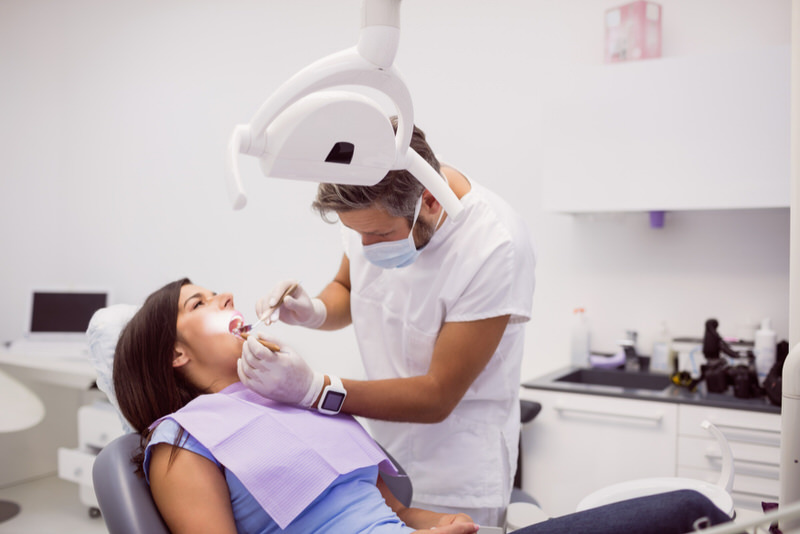It’s common for a patient to suffer from a dry socket soon after tooth extraction. The dry socket is accompanied by severe pain and foul breath. A dentist performs many treatments for a dry socket, and one of the common treatments is a “packing” that is smearing medication onto a piece of gauze or cotton, which is then placed directly into your tooth socket. The “packing” is placed to control bleeding as a means of pain relief and for speedy healing. You do need to replace the dressing as per your doctor’s advice, but in case the dressing falls out before the dentist was supposed to replace it or remove it. It’s best to give your dentist a visit so that they can analyze the healing of the affected area and determine whether a dressing replacement is needed or not.
Suffering through the tooth pain, then having the tooth extracted and making sure that the affected area is healing properly is already stressful enough, let alone having to know that you now have a dry socket at the affected area and the packing has just fallen out!
Before we deep dive into your extraction area, let’s first state all the facts-
What is a dry socket?

A dry socket is usually one of the common complications occurring after a wisdom tooth extraction.
Dry socket, also known as alveolar osteitis or fibrinolytic osteitis, usually happens if food debris enters the affected area or if you have strained the site either by sucking through a straw or spitting, smoking, has poor oral hygiene. This can end up exposing the nerves in your jaw, which causes excruciating pain.
In simple terms, what happens is, after your wisdom tooth removal, there forms a blood clot over the affected area to stop any bacteria from entering and from exposing the underlying jawbone.
If this blood clot is lost or fails to form before the area can heal, the bone is exposed, and healing is delayed.
Dry socket mostly takes place 3-5 days after the surgery and lasts up to 7 days. Dry socket is more common in the lower molar than the upper.
Symptoms of a dry socket
- One of the first signs of dry socket is the loss of a blood clot and the visible jawbone.
- You might feel excruciating pain in the affected area.
- The surrounding tissue of the affected area may appear gray because of a delay in healing.
- The pain may radiate to other parts like the eyes and ears of the same side.
- You may also experience the bad taste and foul smell in your mouth because of the build-up of food debris and bacteria in the area where the tooth was extracted.
How is dry socket treated?
There are many treatment options for a dry socket, and each focuses on pain management and relieving pain from the affected area.
Medications
One of the standard treatments is over-the-counter medications. Dry socket usually lasts for 3-5 days, so that you might be prescribed some medications or even topical anesthetics.
Packing
Suppose over-the-counter medications don’t work, which is quite common.
In that case, your dentist may prescribe you to have a dressing over the affected area to protect the underlying jawbone from getting exposed and prevent further infection.
First, the dentist anesthetizes the area and removes any debris or dead tissue on the exposed bone. Then the dentist will rinse away the area with a saline wash and dry out the socket gently with suction.
The dentist will then “pack” the extraction site a dressing. The “packing” is a simple dressing with medications applied like a paste onto a piece of gauze or cotton and placed at the extraction site.
There are usually two types of “packing”- one is medicated gauze or cotton that you need to replace and remove as recommended by your dentist, and the second is hemostatic packs that dissolve on their own within 2-5 days.
Depending on the severity of your case, you might have to replace the dressing within 24 hours at the dentist’s office. The dressing will act as a protective layer and prevent debris or bacteria from entering the affected area.
Surgery
Sometimes the dentist may suggest surgery in some cases to speed up the healing process.
What should I do if my dry socket packing falls off?
If your dentist has used a medicated gauze or a piece of cotton, then you need to replace them every 24 hours, depending on the severity of your case.
In case your packing falls off before the extraction site is adequately healed, then you need to book another appointment with your dentist to place a new dressing and get it replaced regularly.
Home remedies for dry socket
If a dry socket has occurred, then you need to manage the pain and give the socket a chance and time to heal.
Here are a few home remedies you can follow to manage your pain:
- Rinse your mouth gently with warm salt water
- Use clove oil or OTC oral anesthetic to numb the pain
- Brush carefully and gently around the affected area
- Use cold compress over the affected area
- Refrain from smoking
- Take OTC medications after consulting with your dentist
FAQs
Is dry socket treatment painful?
The dentist will use a local anesthetic to clean and place the dressing in the extraction site, and you might experience immediate relief from pain.
Can I go to work the next day after wisdom tooth extraction?
It’s usually recommended to take a day or two off works after a wisdom tooth extraction.
When can I stop worrying about dry sockets?
You have to observe it as long as it’s fully healed, and this might take 7 – 10 days after treatment.
Can dry socket heal on its own?
A dry socket can heal on its own as long as you don’t irritate the affected area and rinse it regularly with warm saline. If you feel extreme discomfort, it’s best to take OTC medications after consulting your dentist.
Takeaway
Dry socket is very painful, and sometimes it can become unbearable, but with proper treatment and taking care of the affected area, the pain should subside down with a few days.
But don’t keep ignoring if the pain is extreme because there’s a chance you might develop an infection if debris and bacteria are still present at the extraction site.
Meanwhile, take care and take it easy.


